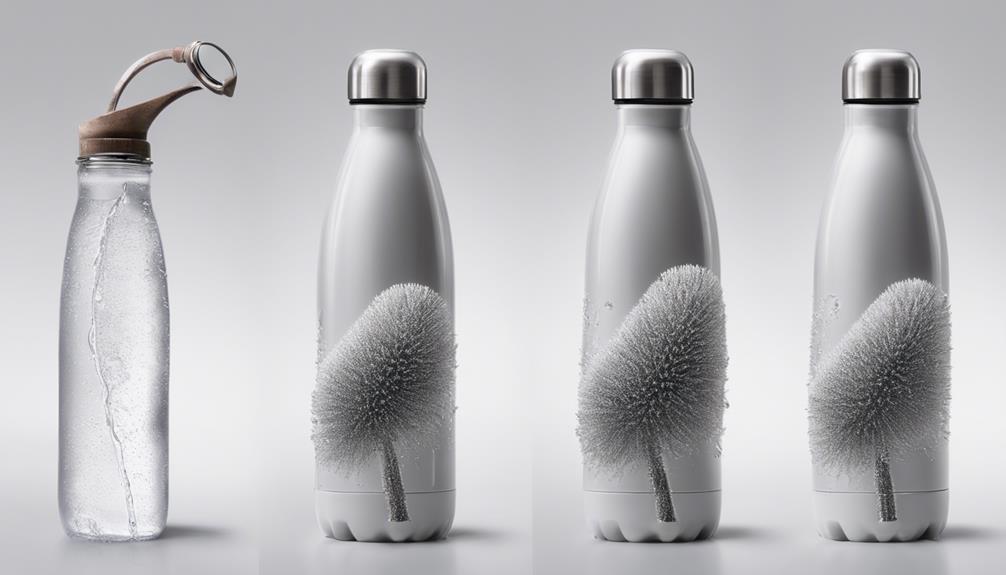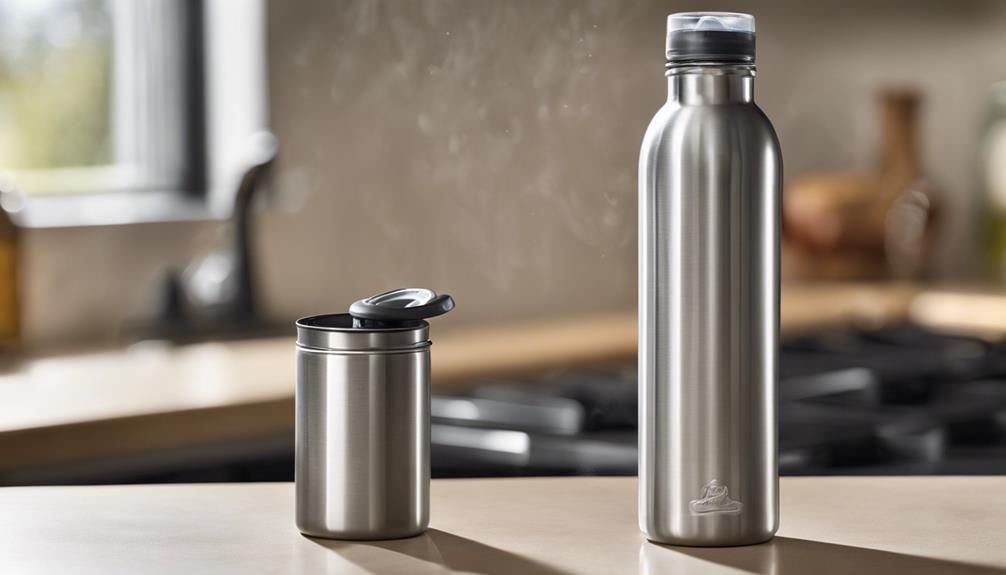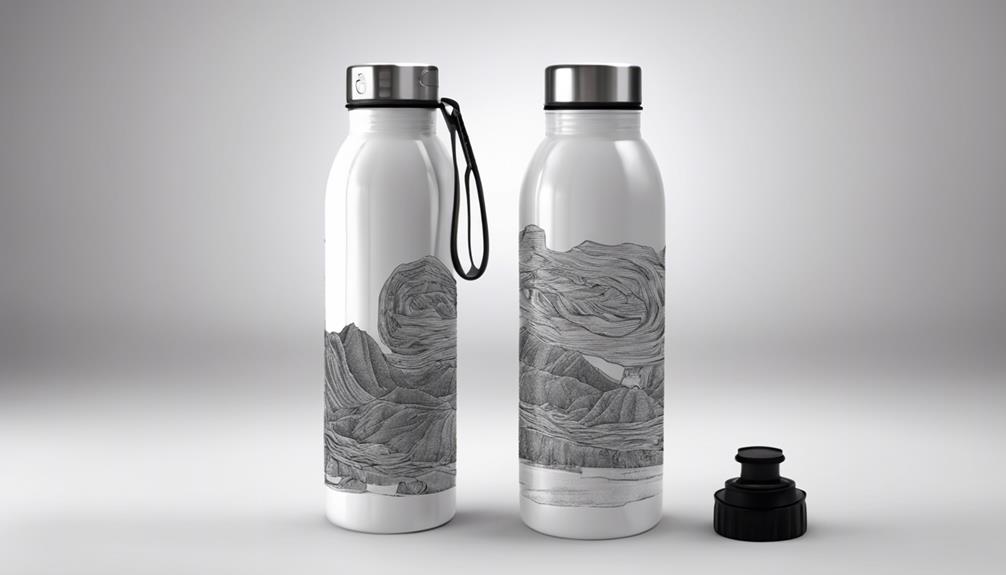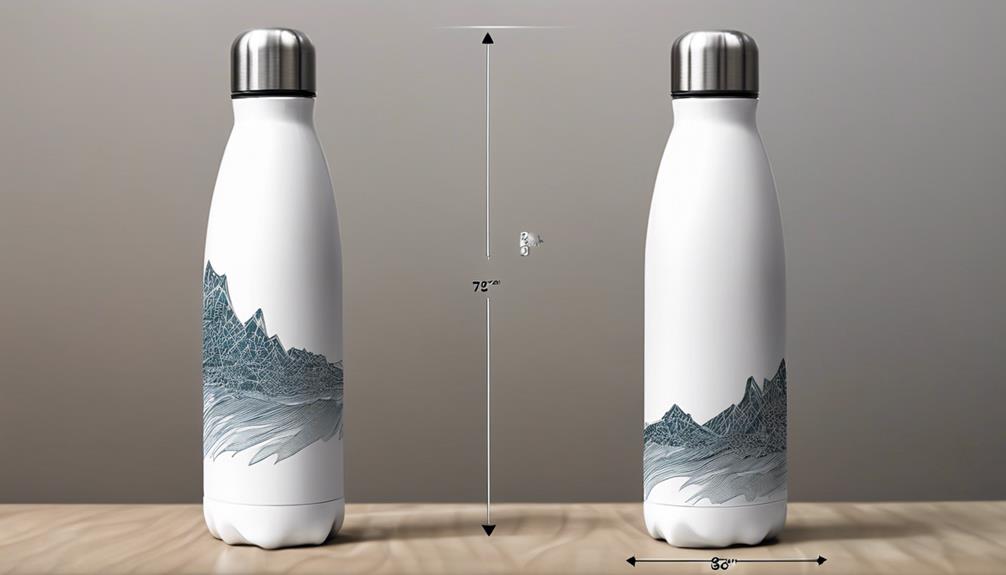To care for your stainless steel water bottle, regularly clean it with warm soapy water using a bottle brush. Prevent scratches by opting for gentle cleansers. Control odors by using a mixture of baking soda and water. Air dry the bottle upside down to avoid moisture buildup, and avoid using heat to speed up drying. Hand wash instead of using a dishwasher and dry with a soft towel to prevent water spots. Inspect for wear and dents regularly. These steps will help maintain your bottle's quality and longevity.
Cleaning Your Water Bottle

To effectively clean your stainless steel water bottle, use warm soapy water and a bottle brush to scrub the interior thoroughly. Cleaning techniques are crucial for preserving the quality of your bottle and ensuring its longevity. The warm soapy water helps to break down any residues or impurities present in the bottle, while the bottle brush allows you to reach all areas for a deep clean.
When considering cleaning your water bottle, it's essential to be mindful of the environmental impact and incorporate sustainability practices. By using natural or eco-friendly soaps, you can minimize the release of harmful chemicals into the environment. Additionally, opting for a reusable bottle and maintaining it properly reduces the need for single-use plastics, contributing to a more sustainable lifestyle.
Removing Tough Stains

Use a stainless steel-safe cleaner and a non-abrasive sponge to effectively remove tough stains from your water bottle.
When tackling stubborn stains on your stainless steel water bottle, it's essential to follow the right techniques to prevent damage and maintain its quality.
Here are some tips for tough stain removal and prevention:
- Gentle Cleanser: Opt for a stainless steel-specific cleaner to avoid scratching the surface of your water bottle.
- Non-Abrasive Tools: Use a soft-bristled brush or a non-abrasive sponge to scrub away the stains gently without causing any damage to the bottle.
- Soaking Method: For deep cleaning, let the bottle soak in a mixture of warm water and mild detergent to loosen tough stains before scrubbing.
- Regular Maintenance: Implement a routine cleaning schedule to prevent stains from setting in and becoming harder to remove. Consistent cleaning can help maintain the pristine look of your stainless steel water bottle and prolong its lifespan.
Preventing Odors

For maintaining a fresh scent in your stainless steel water bottle, focus on implementing effective methods to prevent odors from developing over time. Odor prevention is key to ensuring your bottle remains pleasant to use.
To start, regularly cleaning your stainless steel water bottle with mild soap and warm water is essential. Ensure you give special attention to the cap and mouthpiece, as these areas are prone to trapping odors.
Additionally, consider using cleaning hacks like a mixture of baking soda and water, allowing it to sit in the bottle for a few hours before rinsing thoroughly.
Odor control can also be achieved by avoiding storing liquids other than water in your bottle, as sugary or acidic beverages can leave lingering smells.
Furthermore, make it a habit to air out your bottle when not in use to prevent odors from accumulating.
Drying Properly

To ensure your stainless steel water bottle remains in optimal condition, it's crucial to properly dry it after each use.
Air drying the bottle upside down helps to prevent moisture buildup and potential odors.
Additionally, using a clean towel to dry the interior thoroughly and wiping the exterior to prevent water spots will maintain the bottle's cleanliness and longevity.
Air Dry Bottle
Ensure the stainless steel water bottle is thoroughly rinsed before placing it upside down to air dry completely. It's essential to allow the bottle to air dry properly to prevent water spots and potential contamination.
Here are some steps to effectively air dry your stainless steel water bottle:
- Thorough Rinse: After washing your bottle, ensure all soap residue is removed by giving it a thorough rinse with clean water.
- Upside Down Position: To allow proper air circulation and drainage, place the bottle upside down on a drying rack or a clean towel.
- Open Cap: Keep the cap off during the drying process to prevent any trapped moisture inside the bottle.
- Patience: Allow the bottle to air dry naturally. Don't rush the process by using heat sources like hair dryers or placing it near direct sunlight.
Use Towel Inside
You can expedite the drying process and eliminate any lingering moisture by utilizing a clean towel inside your stainless steel water bottle. This towel technique is crucial for moisture prevention, as even small traces of water left inside the bottle can lead to bacterial growth.
After washing your bottle, simply insert a dry, clean towel and gently move it around to absorb any remaining moisture. Ensure that the towel reaches all corners and crevices inside the bottle to prevent water spots and inhibit the growth of bacteria.
Proper interior care not only helps maintain the cleanliness of your stainless steel water bottle but also extends its lifespan. By incorporating the towel technique into your bottle maintenance routine, you can significantly reduce the risk of bacteria buildup, which could compromise your health.
Remember to use a fresh towel each time to avoid transferring any contaminants back into the bottle. This simple yet effective method will leave your stainless steel water bottle dry, clean, and ready for your next use.
Prevent Water Spots
Using a soft, lint-free cloth to thoroughly dry your stainless steel water bottle can help prevent the formation of water spots. To ensure your bottle stays spot-free, follow these steps:
- Use a Microfiber Cloth:
Opt for a microfiber cloth to dry your stainless steel water bottle. Microfiber is gentle on the surface and absorbs water efficiently, reducing the chances of water spots forming.
- Dry Immediately After Washing:
After washing your bottle, make sure to dry it promptly to prevent any water from evaporating and leaving spots behind.
- Utilize a Vinegar Rinse:
Occasionally rinsing your stainless steel water bottle with a vinegar solution can help remove any existing spots and prevent new ones from appearing.
- Air Dry Upside Down:
To ensure all water drains out, store your bottle upside down to air dry completely. This method can help prevent water spots on the interior surface of your bottle.
Avoiding Dishwasher Damage
To prevent potential damage, it's recommended to hand wash your stainless steel water bottle instead of using a dishwasher. While dishwashers are convenient, the high temperatures, harsh detergents, and vigorous spray can lead to scratches and wear on the stainless steel surface. Hand washing allows for more control over the cleaning process, reducing the risk of damaging your water bottle.
When hand washing your stainless steel water bottle, use a mild dish soap and a soft sponge or cloth to gently clean the exterior and interior. Avoid abrasive scrubbers or harsh chemicals that can scratch or erode the stainless steel. Rinse the bottle thoroughly with warm water to remove any soap residue.
Additionally, when drying your water bottle, use a soft, clean towel to prevent water spots and maintain the bottle's appearance. Ensuring proper cleaning techniques will help prolong the lifespan of your stainless steel water bottle and keep it looking its best for longer.
Storing Safely

When storing your stainless steel water bottle, ensure you employ proper techniques to maintain its quality.
Avoid exposing it to extreme temperatures, as this can affect its structure and insulation capabilities.
Always keep the lid closed to prevent dust and debris from entering the bottle and contaminating your water.
Proper Storage Techniques
Store your stainless steel water bottle in a cool, dry place away from direct sunlight to maintain its quality and prevent damage. Proper storage techniques are crucial for maximizing the lifespan of your bottle. Follow these tips:
- Choose a Safe Spot: Place your water bottle in a secure location where it won't be knocked over or bumped to prevent scratches and dents.
- Use a Protective Sleeve: Consider using a protective sleeve or cover to add an extra layer of defense against minor impacts and scratches.
- Keep it Dry: Ensure the interior of the bottle is completely dry before storing it to prevent the growth of bacteria and maintain its cleanliness.
- Avoid Harsh Chemicals: When storing, avoid contact with harsh chemicals or cleaning agents that could potentially damage the stainless steel or affect the quality of your beverages.
Avoid Extreme Temperatures
Properly safeguard your stainless steel water bottle by ensuring it isn't exposed to extreme temperatures during storage. Temperature control is crucial to maintaining the integrity of your bottle. Extreme heat can cause the stainless steel to expand, potentially affecting the structural integrity of the bottle. Conversely, extreme cold can cause the metal to contract, leading to potential issues with the bottle's durability.
Thermal shock, which is rapid temperature changes, can also damage your bottle. To prevent this, avoid placing your stainless steel water bottle in the freezer or directly on a stove.
When storing your bottle, consider insulation tips to regulate its temperature. If you plan to use your bottle outdoors in extreme conditions, opt for a bottle sleeve or cozy to help moderate the internal temperature. Remember, extreme temperatures can't only damage the bottle but also affect the quality of the water inside.
Keep Lid Closed
To ensure the safety of your stainless steel water bottle, always keep the lid closed securely when storing it. Properly sealing the lid is crucial to maintaining the quality and integrity of your bottle. Here are some essential points to consider:
- Lid Maintenance:
Regularly check the lid for any signs of wear or damage that may affect its sealing ability. Clean the lid thoroughly to prevent any buildup that could compromise the seal.
- Proper Sealing:
Ensure the lid is tightly closed to prevent leaks and maintain the temperature of your beverages. A secure seal also helps in preserving the freshness of your drinks.
- Lid Material:
Depending on the type of lid your bottle has, consider the material it's made from. Some materials are more durable and offer better sealing properties than others.
- Replacement Options:
If you notice that the lid is no longer sealing properly or is damaged beyond repair, consider replacing it with a new one to maintain the functionality of your stainless steel water bottle.
Routine Maintenance
Performing regular cleaning and inspections on your stainless steel water bottle helps maintain its quality and prolong its lifespan. Regular inspection involves checking for any signs of wear, dents, or scratches that could compromise the integrity of the bottle. It's essential to inspect the bottle inside and out to ensure there are no leaks or areas that may harbor bacteria.
In addition to regular inspections, surface protection is crucial for maintaining the appearance of your stainless steel water bottle. To protect the exterior, consider using a protective sleeve or cover to prevent scratches and dents. This will also help maintain the temperature of your beverages for longer periods.
When cleaning your stainless steel water bottle, use a mild detergent and warm water. Avoid harsh chemicals or abrasive cleaners that could damage the stainless steel. Rinse the bottle thoroughly after cleaning to remove any soap residue.
Frequently Asked Questions
Can I Use My Stainless Steel Water Bottle for Hot Beverages?
Yes, you can use your stainless steel water bottle for hot beverages. However, avoid placing boiling liquids directly inside to prevent burns. Stainless steel retains heat well due to its insulating capabilities, making it suitable for warm drinks.
How Often Should I Replace the Silicone or Rubber Seals?
Replacing silicone or rubber seals every 6-12 months is vital to prevent leaks and maintain insulation. Proper care, like regular cleaning and avoiding harsh chemicals, can extend seal longevity. Neglecting this maintenance can compromise your bottle's performance.
Is It Safe to Add Ice Cubes Directly Into My Water Bottle?
Yes, it's generally safe to add ice cubes directly into your stainless steel water bottle. However, be cautious of potential ice cube impact on durability and condensation concerns affecting your hydration habits due to temperature effects.
Can I Infuse My Water With Fruits or Herbs in a Stainless Steel Bottle?
Yes, you can infuse your water with fruits or herbs in a stainless steel bottle. Fruit infusion provides added flavor and nutrients, while herb infusion offers a refreshing twist. Ensure proper cleaning to prevent residue buildup and maintain freshness.
Will Using a Metal Straw Scratch the Interior of the Bottle?
Hey, metal straws are great for the environment, but they can scratch your bottle's interior. To prevent this, ensure your straws are clean and use caution when inserting them. Regular cleaning helps maintain your bottle's pristine condition.
Conclusion
In conclusion, maintaining the cleanliness and integrity of your stainless steel water bottle is crucial for long-lasting use. By following the proper cleaning techniques, preventing odors, and storing it safely, you can ensure your bottle remains in top condition.
Remember, a little routine maintenance goes a long way in preserving the quality of your stainless steel water bottle, so be diligent in caring for it to enjoy fresh and clean hydration every time.

